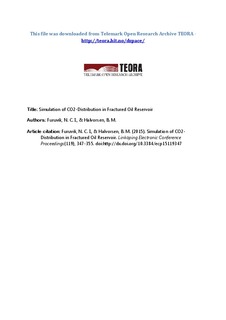Simulation of CO2-Distribution in Fractured Oil Reservoir
Conference object, Peer reviewed
Published version
Permanent lenke
http://hdl.handle.net/11250/2438481Utgivelsesdato
2015-11-25Metadata
Vis full innførselSamlinger
Originalversjon
Furuvik, N. C. I., & Halvorsen, B. M. (2015). Simulation of CO2-Distribution in Fractured Oil Reservoir. Paper presented at the 56th Conference on Simulation and Modelling (SIMS 56), October, 7-9, 2015, Linköping University, Sweden. doi:http://dx.doi.org/10.3384/ecp15119347 http://dx.doi.org/10.3384/ecp15119347Sammendrag
Deep geologic injections and storage of Carbon dioxide (CO2) for enhanced oil recovery (EOR) are an upcoming combination due to the potential for increased oil production from depleted oilfields at the same time reducing the carbon footprint from industrial sources. CO2-EOR refers to a technique for injection of supercritical-dense CO2 into an oil reservoir. Remaining oil, not producible by primary and secondary techniques, has been successfully produced using EOR with CO2 since early 1970??. CO2 mixes with oil and changes the oil properties making the immobile oil mobile and producible. Coupled CO2-EOR and storage is an attractive storage option because of its potential to increase the oil production from mature oilfields. The reservoir physical properties (porosity, permeability) together with fluid properties significantly affect the CO2 storage and CO2-EOR performance. This study focus on CO2 storage and CO2-EOR in carbonate reservoirs including simulations of CO2-distribution in the rock. Carbonate reservoirs are characterized by low permeability and high heterogeneity causing significant amount of CO2 to be recycled. The simulations are carried out using a commercial reservoir simulation software. Criteria for the performed simulations are a highly heterogeneous carbonate reservoir with fractures. The results are discussed.
